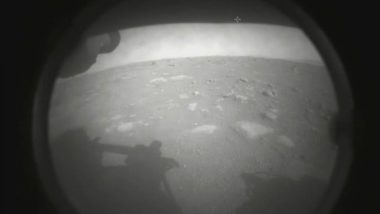Washington, February 19: American independent space agency, the National Aeronautics and Space Administration (NASA) on Thursday (local time) announced that its largest and most advanced rover has touched down on Mars.
The Perseverance rover reached Mars after covering 203-day journey traversing 293 million miles (472 million kilometers). The touch down was confirmed at NASA's Jet Propulsion Laboratory in Southern California at 3:55 pm EST (local time). Meet Indian American Dr Swati Mohan, Who Leads NASA’s Operation Perseverance Rover Landing on Mars.
Packed with groundbreaking technology, the Mars 2020 mission launched July 30, 2020, from Cape Canaveral Space Force Station in Florida. The Perseverance rover mission marks an ambitious first step in the effort to collect Mars samples and return them to Earth, according to an official statement.
NASA's Most-advanced Perseverance Rover Successfully Touches Down on Mars
Celebrations around the world marked the historic touchdown of @NASAPersevere at her new home: Mars.
Relive the #CountdownToMars in our @Twitter Moment:https://t.co/q0mjRA8AHu
— NASA (@NASA) February 19, 2021
Terming the landing as one of those pivotal moments for NASA, the United States, and space exploration globally, acting NASA Administrator Steve Jurczyk said: "The Mars 2020 Perseverance mission embodies our nation's spirit of persevering even in the most challenging of situations, inspiring, and advancing science and exploration. The mission itself personifies the human ideal of persevering toward the future and will help us prepare for human exploration of the Red Planet in the 2030s."
The rover is about the size of a car, the 2,263-pound (1,026-kilogram) robotic geologist and astrobiologist will undergo several weeks of testing before it begins its two-year science investigation of Mars' Jezero Crater.
While the rover will investigate the rock and sediment of Jezero's ancient lakebed and river delta to characterise the region's geology and past climate, a fundamental part of its mission is astrobiology, including the search for signs of ancient microbial life. To that end, the Mars Sample Return campaign, being planned by NASA and the European Space Agency (ESA), will allow scientists on Earth to study samples collected by Perseverance to search for definitive signs of past life using instruments too large and complex to send to the Red Planet.
Thomas Zurbuchen, associate administrator for science at NASA said Perseverance is the first step in bringing back rock and regolith from Mars.
"Because of today's exciting events, the first pristine samples from carefully documented locations on another planet are another step closer to being returned to Earth," said Thomas Zurbuchen, associate administrator for science at NASA.
"We do not know what these pristine samples from Mars will tell us. But what they could tell us is monumental - including that life might have once existed beyond Earth," Zurbuchen said.
Meanwhile, Lori Glaze, director of NASA's Planetary Science Division, said, "Perseverance is the most sophisticated robotic geologist ever made, but verifying that microscopic life once existed carries an enormous burden of proof."
"While we will learn a lot with the great instruments we have aboard the rover, it may very well require the far more capable laboratories and instruments back here on Earth to tell us whether our samples carry evidence that Mars once harboured life," Glaze added.
(This is an unedited and auto-generated story from Syndicated News feed, LatestLY Staff may not have modified or edited the content body)













 Quickly
Quickly





















